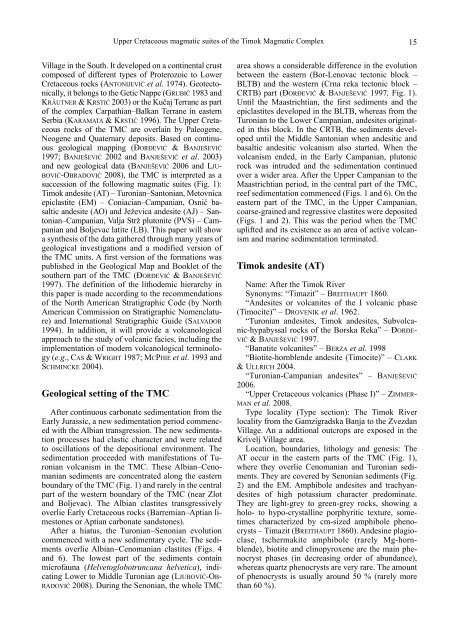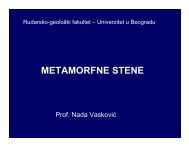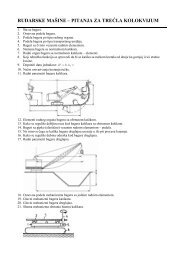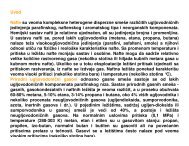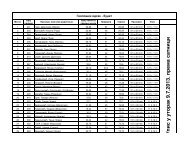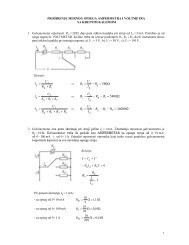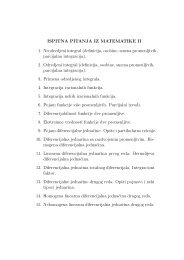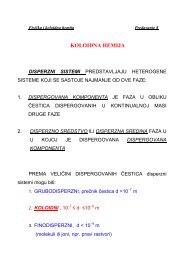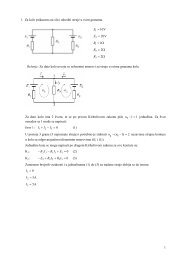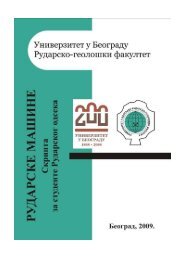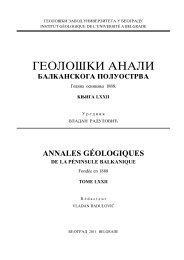KÑига LXXI - Univerzitet u Beogradu
KÑига LXXI - Univerzitet u Beogradu
KÑига LXXI - Univerzitet u Beogradu
You also want an ePaper? Increase the reach of your titles
YUMPU automatically turns print PDFs into web optimized ePapers that Google loves.
Upper Cretaceous magmatic suites of the Timok Magmatic Complex 15<br />
Village in the South. It developed on a continental crust<br />
composed of different types of Proterozoic to Lower<br />
Cretaceous rocks (ANTONIJEVIĆ et al. 1974). Geotectonically,<br />
it belongs to the Getic Nappe (GRUBIĆ 1983 and<br />
KRÄUTNER & KRSTIĆ 2003) or the Kučaj Terrane as part<br />
of the complex Carpathian–Balkan Terrane in eastern<br />
Serbia (KARAMATA & KRSTIĆ 1996). The Upper Cretaceous<br />
rocks of the TMC are overlain by Paleogene,<br />
Neogene and Quaternary deposits. Based on continuous<br />
geological mapping (ĐORĐEVIĆ & BANJEŠEVIĆ<br />
1997; BANJEŠEVIĆ 2002 and BANJEŠEVIĆ et al. 2003)<br />
and new geological data (BANJEŠEVIĆ 2006 and LJU-<br />
BOVIĆ-OBRADOVIĆ 2008), the TMC is interpreted as a<br />
succession of the following magmatic suites (Fig. 1):<br />
Timok andesite (АТ) – Turonian–Santonian, Metovnica<br />
epiclastite (ЕМ) – Coniacian–Campanian, Osnić basaltic<br />
andesite (АО) and Ježevica andesite (AJ) – Santonian–Campanian,<br />
Valja Strž plutonite (PVS) – Campanian<br />
and Boljevac latite (LB). This paper will show<br />
a synthesis of the data gathered through many years of<br />
geological investigations and a modified version of<br />
the TMC units. A first version of the formations was<br />
published in the Geological Map and Booklet of the<br />
southern part of the TMC (ĐORĐEVIĆ & BANJEŠEVIĆ<br />
1997). The definition of the lithodemic hierarchy in<br />
this paper is made according to the recommendations<br />
of the North American Stratigraphic Code (by North<br />
American Commission on Stratigraphic Nomenclature)<br />
and International Stratigraphic Guide (SALVADOR<br />
1994). In addition, it will provide a volcanological<br />
approach to the study of volcanic facies, including the<br />
implementation of modern volcanological terminology<br />
(e.g., CAS & WRIGHT 1987; MCPHIE et al. 1993 and<br />
SCHMINCKE 2004).<br />
Geological setting of the TMC<br />
After continuous carbonate sedimentation from the<br />
Early Jurassic, a new sedimentation period commenced<br />
with the Albian transgression. The new sedimentation<br />
processes had clastic character and were related<br />
to oscillations of the depositional environment. The<br />
sedimentation proceeded with manifestations of Turonian<br />
volcanism in the TMC. These Albian–Cenomanian<br />
sediments are concentrated along the eastern<br />
boundary of the TMC (Fig. 1) and rarely in the central<br />
part of the western boundary of the TMC (near Zlot<br />
and Boljevac). The Albian clastites transgressively<br />
overlie Early Cretaceous rocks (Barremian–Aptian limestones<br />
or Aptian carbonate sandstones).<br />
After a hiatus, the Turonian–Senonian evolution<br />
commenced with a new sedimentary cycle. The sediments<br />
overlie Albian–Cenomanian clastites (Figs. 4<br />
and 6). The lowest part of the sediments contain<br />
microfauna (Helvetoglobotruncana helvetica), indicating<br />
Lower to Middle Turonian age (LJUBOVIĆ-OB-<br />
RADOVIĆ 2008). During the Senonian, the whole TMC<br />
area shows a considerable difference in the evolution<br />
between the eastern (Bor-Lenovac tectonic block –<br />
BLTB) and the western (Crna reka tectonic block –<br />
CRTB) part (ĐORĐEVIĆ & BANJEŠEVIĆ 1997, Fig. 1).<br />
Until the Maastrichtian, the first sediments and the<br />
epiclastites developed in the BLTB, whereas from the<br />
Turonian to the Lower Campanian, andesites originated<br />
in this block. In the CRTB, the sediments developed<br />
until the Middle Santonian when andesitic and<br />
basaltic andesitic volcanism also started. When the<br />
volcanism ended, in the Early Campanian, plutonic<br />
rock was intruded and the sedimentation continued<br />
over a wider area. After the Upper Campanian to the<br />
Maastrichtian period, in the central part of the TMC,<br />
reef sedimentation commenced (Figs. 1 and 6). On the<br />
eastern part of the TMC, in the Upper Campanian,<br />
coarse-grained and regressive clastites were deposited<br />
(Figs. 1 and 2). This was the period when the TMC<br />
uplifted and its existence as an area of active volcanism<br />
and marine sedimentation terminated.<br />
Timok andesite (AT)<br />
Name: After the Timok River<br />
Synonyms: “Timazit” – BREITHAUPT 1860.<br />
“Andesites or volcanites of the I volcanic phase<br />
(Timocite)” – DROVENIK et al. 1962.<br />
“Turonian andesites, Timok andesites, Subvolcanic-hypabyssal<br />
rocks of the Borska Reka” – ĐORĐE-<br />
VIĆ & BANJEŠEVIĆ 1997.<br />
“Banatite volcanites” – BERZA et al. 1998<br />
“Biotite-hornblende andesite (Timocite)” – CLARK<br />
& ULLRICH 2004.<br />
“Turonian-Campanian andesites” – BANJEŠEVIĆ<br />
2006.<br />
“Upper Cretaceous volcanics (Phase I)” – ZIMMER-<br />
MAN et al. 2008.<br />
Type locality (Type section): The Timok River<br />
locality from the Gamzigradska Banja to the Zvezdan<br />
Village. An a additional outcrops are exposed in the<br />
Krivelj Village area.<br />
Location, boundaries, lithology and genesis: The<br />
AT occur in the eastern parts of the TMC (Fig. 1),<br />
where they overlie Cenomanian and Turonian sediments.<br />
They are covered by Senonian sediments (Fig.<br />
2) and the EM. Amphibole andesites and trachyandesites<br />
of high potassium character predominate.<br />
They are light-grey to green-grey rocks, showing a<br />
holo- to hypo-crystalline porphyritic texture, sometimes<br />
characterized by cm-sized amphibole phenocrysts<br />
– Timazit (BREITHAUPT 1860). Andesine plagioclase,<br />
tschermakite amphibole (rarely Mg-hornblende),<br />
biotite and clinopyroxene are the main phenocryst<br />
phases (in decreasing order of abundance),<br />
whereas quartz phenocrysts are very rare. The amount<br />
of phenocrysts is usually around 50 % (rarely more<br />
than 60 %).


